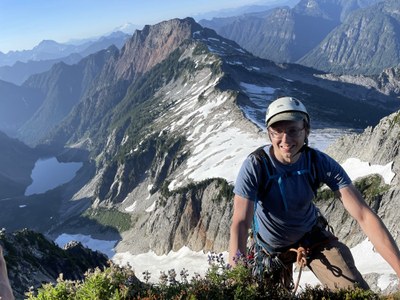
Trip Report
Intermediate Alpine Climb - Vesper, Sperry & Wolf Peaks
Beta for 3 Intermediate Climbs: Fish & Whistle, True Grit, and Ragged Edge!
- Sat, Jul 24, 2021
- Intermediate Alpine Climb - Vesper, Sperry & Wolf Peaks
- Vesper, Sperry & Wolf Peaks
- Climbing
- Successful
-

- Road suitable for all vehicles
-
Trip Report 7.24.21 North Face of Vesper
Due to its smoke-free condition, Vesper was very crowded this past weekend. We arrived at 7:30 AM Saturday and the parking lot was so full that we had to park down the road. If you must go on a weekend, I’d recommend starting earlier or camping at the trailhead to try and beat the crowds.
The stream crossings were a bit high on the approach, and after two warm days, were higher on the descent. Consider bringing an extra pair of shoes. Trekking poles were helpful.
To access the climbs follow the scramble trail through Headlee Pass and all the way up until a ledge at an elevation of around 5760 ft. You will see a cairn on climbers’ right near boulders which are perfect for stashing gear. There wasn’t much snow before this point. We found microspikes useful here, as the snow was slippery and the runnout was steep. Some climbers elected to use ice axes or poles as well, but we didn’t find them necessary. Follow the climbers trail as it hugs the wall on your left, and be very careful! We heard a climber (not in our party) fell and required stitches.
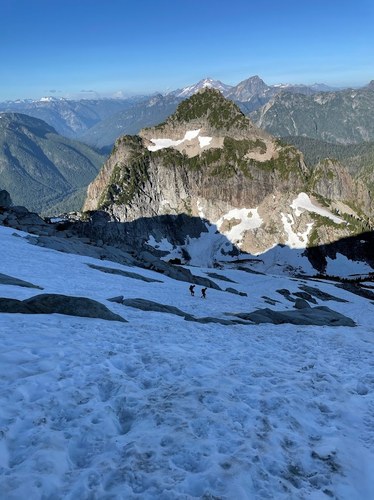
We had two teams of two. Team Sergey/Lauren climbed Fish & Whistle and True Grit while Team Kari/ Tricia climbed Ragged Edges. Specific climb beta is below.
After the climb, Kari and I camped by Lake Elan. The mosquitos were fierce: bug spray and bug nets were helpful. There is no bathroom, so bring blue bags to avoid contaminating the water source. The views are gorgeous though, and worth these minor inconveniences!
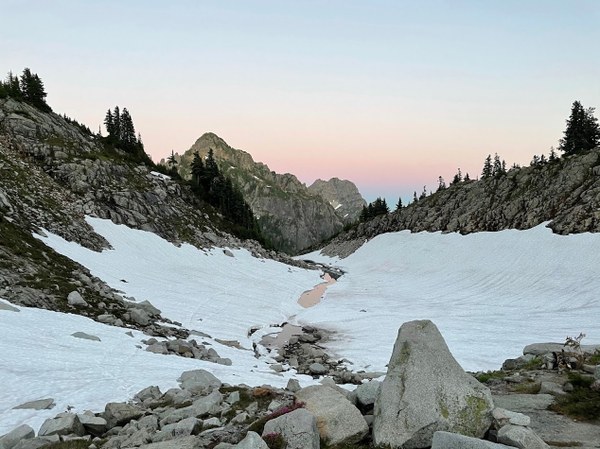
Fish & Whistle- 5 Pitch 5.10- (Linked pitches 3 and 4 with a 60 m)
Gear: Mountain Project Beta says “bring 10 draws, couple small & medium stoppers, single set of cams tiny to 0.75 Camalot, maybe an extra finger size cam or two.” I would add that 5 alpine draws were helpful for linking and I was happy to have doubles of gray size 00 TCUs, gray size .4 C4s.
Pitch 1 (5.10 slab) is thin, technical, and not closely bolted. The party in front of us opted to skip the first pitch by climbing the gully to its left, but then they struggled on the 5.9 pitch which also involved a bit of run out slab. Sergey led this pitch like a champ. Here’s our beta: stay low during the initial traverse. After that, stay a little right of the bolt line (where the slab has a bit more friction) until the holds finally appear. Consider a panic draw for clipping the high (3rd?) bolt to make the run out a bit shorter.
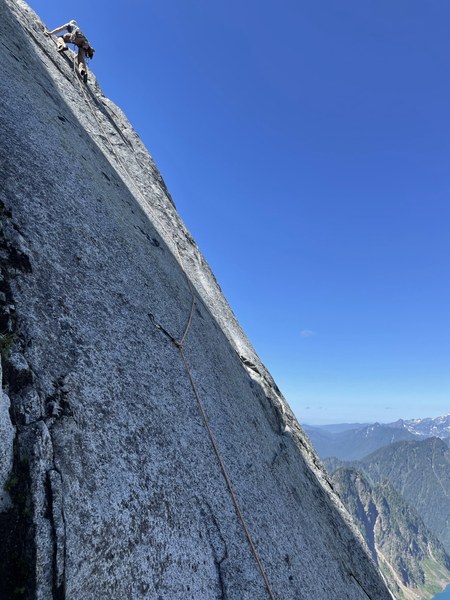
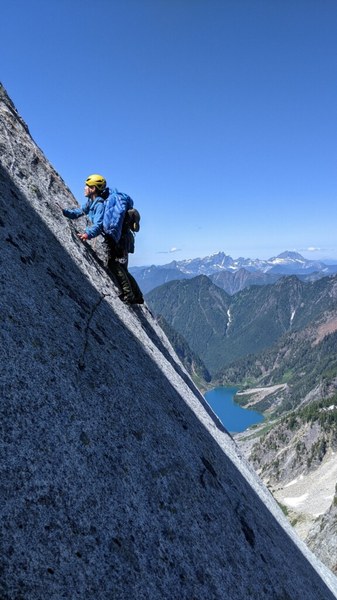
Pitch 2 (5.7) is short and easy, but I am glad I didn’t link it with tricky pitch 3.
Pitch 3 (5.9) Mountain Project Beta says “Juggy rock leads up and right into a nice long seam protected by a mix of gear and bolts.” I would like to add that the seam was at times thin, non continuous, and dirty. This meant that there were a few runout slab parts that were a bit spicy. It was doable and fun for me to lead, but I wouldn’t recommend this pitch for anyone seeking to push their grade. It felt more like a 5.10-, and was significantly easier than the 5th pitch in my opinion.
Pitch 4 (5.6) Closely bolted and very easy to link with pitch 3 if you have alpines.
Pitch 5 (5.10-) A beautiful exposed pitch. MP calls it mixed, but the bolts were close enough that Sergey opted not to place pro. He used a very long cordelette at the top to build an anchor on a boulder.
True Grit - 5 Pitch 5.8 (Linked pitches 2 and 3; 4 and 5* with a 60 m)
Gear: Mountain Project TG Beta says “Single set of cams from micro to BD #2. Narrow head width of TCU/C3 can give you more placement options than a 4 lobe cam for P4. Doubles in fingers to rattly fingers (BD .3-.5). nuts from medium to RPs. Offsets placed well. 60cm slings and one or two 120cm,” which I think is spot on. For linking pitches 4 and 5 I used a lot more alpines (maybe 3 singles and 2 doubles?) *Linking pitches 4 and 5 was a rope stretcher which I don’t recommend with a 60m.
Pitch 1: 5.4. I climbed left, then up through a notch. Then there were easy cracks on the right side. I placed gear with long slings for directionals before traversing left below the chimney.
Pitch 2: 5.8 I skipped the chimney and climbed the dihedral to its right and was very careful to avoid knocking down the grapefruit-sized rocks atop it. MP calls the slab move “difficult,” but I found it easy and very well protected by bolts.
Pitch 3: 5.7 Unable to see the anchor due to sun glare, I went a little too far to the left at the “jigsaw rock” part. It was easy to traverse right and back clean to avoid rope drag.
Pitch 4: 5.8 This pitch was beautiful!!!! It reminded be of the final pitch of Birdland in Red Rocks. It has a clean splitter finger crack and lovely exposure. MP warns of the step across, where you go right after the first crack peters out, but I thought it was fun and well protected by a bolt.
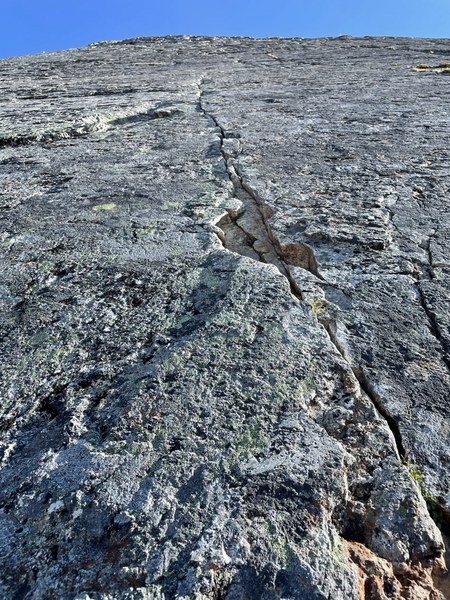
Pitch 5: 5.6 Described by MP as “scruffy,” I was surprised at how well bolted and clean this pitch was. Linking it with pitch 4 meant I was almost out of rope by the end, so I made a less than stellar anchor at the top. I’d recommend not linking so that you’ll have more choices for anchors.
Kari caught this pic of me topping out. Note the beautiful wildflowers growing on the route!
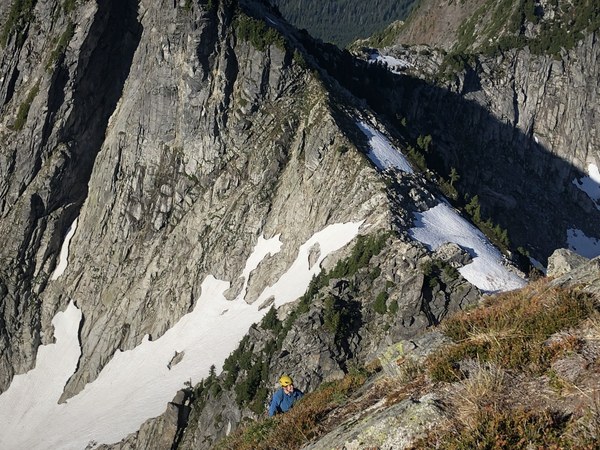
Ragged Edges 6 Pitch 5.7
Gear: Mountain Project RE beta says “Doubles of .5 - 1, singles of .2 - .4, 2, 3, and a set of small nuts.”
Here are Kari’s comments on her lead:
I brought doubles of .2- 1 and one #2 and #3 and no nuts. I did not use the #3. There were lots of good placements. Rock quality was good with few loose rocks. The first pitch felt very short and we accidentally linked pitches 1 and 2 which barely worked with a 70m rope and caused some rope drag. I felt the route was technically easy, but the exposure and awesome views kept it interesting. This route was extremely popular and even arriving in the afternoon we encountered a line up at the base. I also encountered climbers who arrived the night before and camped at the lake ready for an early start- I recommend doing this or climbing it during the week.
Here are Kari's photos of pitch 1 and topping out:
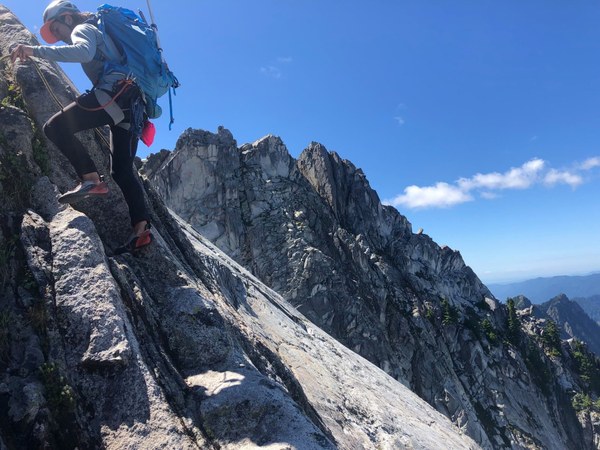
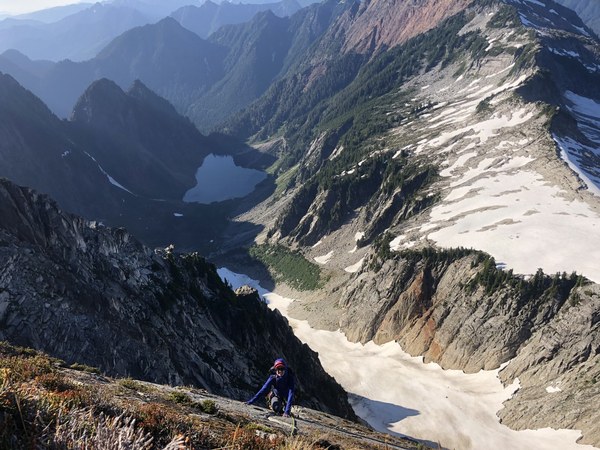
Thank you, Kari for the beta and a great climb!
 Lauren Allen
Lauren Allen